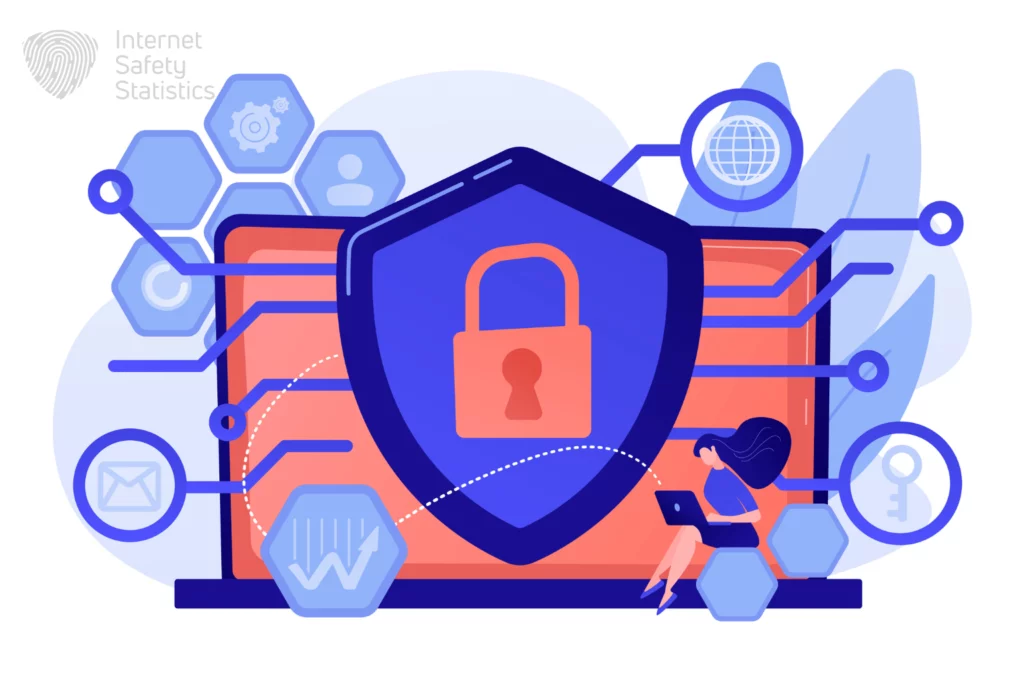
Network security is a critical component of modern digital operations but is often misunderstood by users. Here, we will delve into network security policies and discuss how to protect ourselves from various vulnerabilities and security breaches.
What is Network Security?
Network security is a set of measures that protect networks and their data from unauthorised access, misuse, or other threats. It involves implementing various measures to safeguard network resources’ integrity, confidentiality, and availability. This includes using firewalls, antivirus software, encryption, and other security protocols to prevent unauthorised access and protect sensitive information from being compromised. Network security also encompasses the continuous monitoring and detection of potential threats and the implementation of proactive measures to mitigate risks and ensure the overall safety of the network infrastructure.
Types of Network Security

There are various types of network security, including but not limited to firewalls, encryption, intrusion detection systems, and access control mechanisms. Each type is tailored to address specific security concerns within the network environment, ultimately contributing to a comprehensive security posture.
1. Firewalls are a common type of network security that acts as a barrier between untrusted external networks, such as the Internet, and a trusted internal network. They control the incoming and outgoing network traffic based on an applied rule set and are an essential tool for preventing unauthorised access to or from a private network.
2. Encryption is another crucial aspect of network security that involves encoding data in such a way that only authorised parties can access it. This ensures that even if the data is intercepted, it cannot be read without the proper decryption keys.
3. Intrusion detection systems (IDS) are designed to monitor network traffic for any suspicious activity or behaviour that could indicate a potential security breach. They can either be network-based, monitoring traffic on the network, or host-based monitoring activity on individual devices.
4. Access control mechanisms, such as authentication and authorisation protocols, are used to restrict access to certain parts of a network and ensure that only authorised users or devices are allowed to access sensitive information or resources.
5. Other types of network security include virtual private networks (VPNs) for secure remote access, antivirus and antimalware software for protecting against malicious software, and security information and event management (SIEM) systems for monitoring and managing security events across the network.
Overall, a combination of these network security measures is essential for maintaining a resilient and secure network environment, protecting against a wide range of threats and vulnerabilities.
Importance of Network Security
Adequate network security is crucial for protecting sensitive data, preventing unauthorised access, and ensuring computer networks‘ continuous and secure operation. It preserves the confidentiality and integrity of information while thwarting potential threats and security breaches.
What are Security Policies?
Security policies are a set of rules and guidelines put in place to ensure the confidentiality, integrity, and availability of an organisation’s information and resources. These policies outline the acceptable use of technology and define the roles and responsibilities of employees in safeguarding the company’s assets. These policies also address how to handle security incidents and breaches and establish the criteria for applying security measures. They serve as a roadmap for managing and maintaining security within an organisation and are essential for protecting against potential threats and risks.
Understanding Security Policies
Security policies are formal documents that define the rules, practices, and procedures governing network resources and information use and management. These policies establish the framework for implementing and enforcing security controls and best practices, guiding organisations in securing their network environments.
Types of Security Policies
There are different types of security policies, such as acceptable use, password, and access control policies. These policies address specific security issues and vulnerabilities within the network and outline the necessary measures to mitigate risks and protect against potential breaches.
1. Acceptable use policy outlines the acceptable ways in which employees can use company resources, such as computers, the Internet, and email. It also specifies the consequences of violating the policy and helps prevent unauthorised access and misuse of company resources.
2. Password policy sets the guidelines for creating and maintaining strong passwords, including requirements for length, complexity, and frequency of updates. It also addresses measures for protecting and storing passwords securely to prevent unauthorised access to accounts and sensitive information.
3. Access control policy governs the access rights and permissions granted to employees, contractors, and other users within the organisation. It specifies the procedures for granting, revoking, and managing access privileges and using multi-factor authentication and other security measures to control access to sensitive data and systems.
4. Other security policies include data protection, network security, mobile security, and incident response policies. These policies are essential for establishing a comprehensive security framework and ensuring the protection of critical assets and information within an organisation. Regular review and updates to these policies are necessary to address evolving threats and compliance requirements in the ever-changing cybersecurity landscape.
Creating a Security Policy Template
Developing a security policy template involves outlining the key components and principles that should be included in an organisation’s security policies. It acts as a baseline for creating tailored security policies aligned with the company’s specific requirements and security objectives.
How to Implement Network Security Policies

Implementing network security policies requires careful planning and consideration. First, you must thoroughly assess your organisation’s network infrastructure to identify potential vulnerabilities. Then, it would help if you established comprehensive security policies addressing specific threats and risks. These policies should cover access control, data encryption, and malware detection.
Once the guidelines are in place, monitoring and enforcing them regularly is crucial to ensure compliance. Ongoing employee training and awareness programs are also essential to ensure everyone understands and follows the established security protocols.
1. Enforcing an acceptable use policy ensures that network resources are utilised consistently with organisational objectives and in compliance with security best practices. It defines permissible activities and prohibited actions to maintain the security and integrity of the network environment.
2. Encryption is vital to network security, as it facilitates the secure transmission and storage of sensitive information, rendering it unreadable to unauthorised individuals. Implementing robust encryption mechanisms helps fortify the security of data transmitted across the network.
3. An incident response plan outlines the procedures and actions to be taken during a security incident or breach. It defines the roles and responsibilities of the incident response team, ensuring a coordinated and effective response to security incidents to minimise their impact on the network environment.
What are the Best Practices for Network Security?
The best practices for network security include implementing strong access controls, such as multi-factor authentication and least privilege access. Regularly updating and patching software and systems and conducting regular security audits and assessments can help identify and remediate vulnerabilities. Employing encryption for sensitive data in transit and at rest and maintaining a robust incident response plan can bolster network security.
Additionally, educating employees about cybersecurity best practices and conducting regular training sessions can help mitigate the risk of human error leading to security breaches. A proactive and multi-layered approach to network security is essential for protecting sensitive information and preventing unauthorised access.
VPN Usage for Network Security
Virtual private networks (VPNs) offer a secure and encrypted connection for remote users accessing the company network. Implementing VPN usage enhances network security by establishing a secure communication channel safeguarding data transmission over external networks.
Importance of Password Policies
Effective password policies dictate the rules for creating, managing, and safeguarding passwords for accessing network resources. They play a vital role in preventing unauthorised access to sensitive information and are fundamental to network security best practices.
Audit and Access Control in Network Security
Audit and access control mechanisms help monitor and regulate users’ activities on the network. These security controls verify the compliance of user actions with the established security policies, contributing to the overall security posture of the network environment.
How to Address Security Risks and Vulnerabilities?
Addressing security risks and vulnerabilities requires a proactive approach to identifying and mitigating potential threats. This can involve regular security assessments and audits to identify weaknesses in systems and processes.
Developing and implementing a robust security strategy and framework is vital to protect against cyber attacks, data breaches, and other security threats. This may include implementing encryption, multi-factor authentication, and regular employee security training. Keeping updated with the latest security trends and technologies is also essential to stay ahead of emerging threats. Additionally, having a response plan for security incidents can help minimise the impact and enable a quick recovery.
Conducting Vulnerability Assessments
Regular vulnerability assessments are essential for identifying and evaluating potential security vulnerabilities within the network. By systematically assessing the network environment, organisations can proactively address and mitigate security risks, fortifying their defences against malicious threats.
Dealing with Security Breaches and Incidents
In a security breach or incident, swift and decisive action is imperative to minimise the impact and contain the threat. Organisations must have predefined processes and response strategies in place to effectively address and remediate security breaches, ensuring the resiliency of the network environment.
Implementing Email Security Measures
Email security measures encompass various technologies and practices to secure email communications and protect against threats, such as phishing, malware, and unauthorised access. Implementing robust email security measures bolsters the overall network security by mitigating risks associated with email-based attacks.
In Conclusion
Network security policies form the cornerstone of an organisation’s cyber defence strategy. By encompassing access control, data encryption, and incident response, these policies establish a comprehensive framework for mitigating cyber risks and fortifying the integrity and confidentiality of network resources. With a proactive and holistic approach to policy formulation and implementation, organisations can effectively navigate the complex cybersecurity landscape and foster a resilient digital infrastructure. Remember, a strong network security policy is like a fortress protecting your organisation’s digital assets, and it’s essential for safeguarding against the ever-evolving threat landscape.
